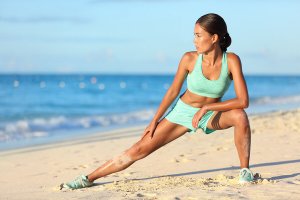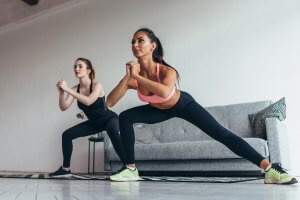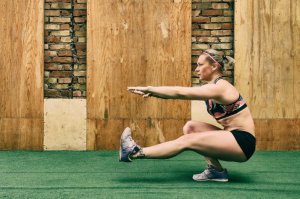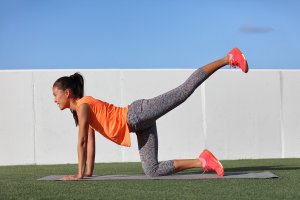Squat Variations for Bigger and Stronger Legs

Achieving massive and stronger legs requires, without a doubt, a lot of work. Sometimes, this task isn’t so simple. By exercising your torso and doing the squat variations that we have to offer, you can generate more spectacular results in less time.
Gaining big biceps, triceps, and pectorals can usually happen quite quickly. However, gaining strength and muscle mass in the legs is very important and takes a little more time and effort.
This is relevant not only for aesthetic reasons but also to avoid injuries during training and to improve performance during physical activity.
Not only that, but leg muscles are so large that they continue to consume calories even when you’re resting. This is why they’re a great help when it comes to losing weight.
Squat variations to strengthen your legs
There are plenty of exercises to help you gain bigger and stronger legs: some require weights, while others need gym machines. However, there are also squat variations that can be done at home, which are just as useful.
Squats with a jump
This is a variation of the classic squat, one of the best-known exercises to strengthen the legs and gain muscle mass. It’s a combination of two very practical exercises.
It’s advisable to do this exercise gradually. We have to start slowly until we acquire the correct technique, then we can gradually increase the intensity.
To start, you should stand with your back straight and line-up your feet with your hips. Next, flex your knees until you’re squatting, go as low as possible. It’s similar to doing a deep squat.

When you get up to return to your starting position, you have to do it explosively, jumping with your knees raised. The goal is for your knees to touch your forearms; you can do three sets of eight repetitions two to three times a week.
Lateral lunges
To optimize your effort and to get the most of the lateral lunges, it’s necessary to go as low as possible, until you’re almost squatting. This way, a lot of leg strength and a lot of flexibility will be required; you’ll strain your muscles to the maximum.
When performing the lateral lunge, you should stand with your legs a little wider than the width of your hips. Next, flex one of your knees and tilt towards your other leg.
To do it correctly, it’s necessary to go as low as possible; ideally, the back of your thigh should touch your calf. This is achieved slowly, so take your time and dedicate yourself.

It’s essential to keep your torso as straight as possible. Once you’ve returned to your original position, do the same with your other leg. You must alternate from one leg to another and do three sets of ten repetitions. And if you want to gain muscle mass, a good option is to add some dumbbells.
Pistol squats: one of the most effective squat variations
This exercise may seem a bit more complicated than the previous ones. In fact, it does requires a lot of muscular strength, flexibility, and balance. However, with a little practice, perseverance, and patience, anyone can do it.
To do this exercise, you must stand on one leg and with the other leg straight ahead. Next, bend your hips and knees, lower your torso as if you were going to sit on a chair. Try to go as low as possible, until the back of your thigh touches your calf.

To make it easier to keep your balance, stretch your arms out forward. After returning to your initial position, repeat the exercise with your other leg; it’s advisable to do three sets of ten repetitions, then switch legs.
The donkey kick
This is a classic exercise to strengthen leg muscles and, mainly, the buttocks. To start, you have to put yourself in a quadruped position. From that position, stretch and raise one leg out, keep your toes straight, separating your foot as much as possible from the floor without moving the hip.

While doing the donkey kick, you should feel the gluteus doing most of the work, but you should also feel all of your leg muscles stretching. It’s recommended to do ten repetitions with the same leg and then alternate. In total, three sets of ten repetitions with each leg two to three times a week would be enough.
In conclusion, the squat variations are somewhat advanced exercises that, with practice and patience, you can master without a problem. Your leg muscles will certainly thank you!
Achieving massive and stronger legs requires, without a doubt, a lot of work. Sometimes, this task isn’t so simple. By exercising your torso and doing the squat variations that we have to offer, you can generate more spectacular results in less time.
Gaining big biceps, triceps, and pectorals can usually happen quite quickly. However, gaining strength and muscle mass in the legs is very important and takes a little more time and effort.
This is relevant not only for aesthetic reasons but also to avoid injuries during training and to improve performance during physical activity.
Not only that, but leg muscles are so large that they continue to consume calories even when you’re resting. This is why they’re a great help when it comes to losing weight.
Squat variations to strengthen your legs
There are plenty of exercises to help you gain bigger and stronger legs: some require weights, while others need gym machines. However, there are also squat variations that can be done at home, which are just as useful.
Squats with a jump
This is a variation of the classic squat, one of the best-known exercises to strengthen the legs and gain muscle mass. It’s a combination of two very practical exercises.
It’s advisable to do this exercise gradually. We have to start slowly until we acquire the correct technique, then we can gradually increase the intensity.
To start, you should stand with your back straight and line-up your feet with your hips. Next, flex your knees until you’re squatting, go as low as possible. It’s similar to doing a deep squat.

When you get up to return to your starting position, you have to do it explosively, jumping with your knees raised. The goal is for your knees to touch your forearms; you can do three sets of eight repetitions two to three times a week.
Lateral lunges
To optimize your effort and to get the most of the lateral lunges, it’s necessary to go as low as possible, until you’re almost squatting. This way, a lot of leg strength and a lot of flexibility will be required; you’ll strain your muscles to the maximum.
When performing the lateral lunge, you should stand with your legs a little wider than the width of your hips. Next, flex one of your knees and tilt towards your other leg.
To do it correctly, it’s necessary to go as low as possible; ideally, the back of your thigh should touch your calf. This is achieved slowly, so take your time and dedicate yourself.

It’s essential to keep your torso as straight as possible. Once you’ve returned to your original position, do the same with your other leg. You must alternate from one leg to another and do three sets of ten repetitions. And if you want to gain muscle mass, a good option is to add some dumbbells.
Pistol squats: one of the most effective squat variations
This exercise may seem a bit more complicated than the previous ones. In fact, it does requires a lot of muscular strength, flexibility, and balance. However, with a little practice, perseverance, and patience, anyone can do it.
To do this exercise, you must stand on one leg and with the other leg straight ahead. Next, bend your hips and knees, lower your torso as if you were going to sit on a chair. Try to go as low as possible, until the back of your thigh touches your calf.

To make it easier to keep your balance, stretch your arms out forward. After returning to your initial position, repeat the exercise with your other leg; it’s advisable to do three sets of ten repetitions, then switch legs.
The donkey kick
This is a classic exercise to strengthen leg muscles and, mainly, the buttocks. To start, you have to put yourself in a quadruped position. From that position, stretch and raise one leg out, keep your toes straight, separating your foot as much as possible from the floor without moving the hip.

While doing the donkey kick, you should feel the gluteus doing most of the work, but you should also feel all of your leg muscles stretching. It’s recommended to do ten repetitions with the same leg and then alternate. In total, three sets of ten repetitions with each leg two to three times a week would be enough.
In conclusion, the squat variations are somewhat advanced exercises that, with practice and patience, you can master without a problem. Your leg muscles will certainly thank you!
All cited sources were thoroughly reviewed by our team to ensure their quality, reliability, currency, and validity. The bibliography of this article was considered reliable and of academic or scientific accuracy.
- Miguel Vélez Blasco. 2003. Ejercicios de carga natural. Extraído de: http://fcatletisme.cat/wp-content/uploads/elsexercicisdecarreganatural.pdf
- CrossFit Training Guide. Clínica de sentadillas. Extraído de: http://openboxmagazine.com/documentos/1_sentadilla_libre.pdf
This text is provided for informational purposes only and does not replace consultation with a professional. If in doubt, consult your specialist.








